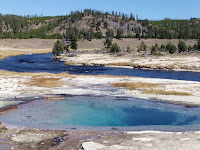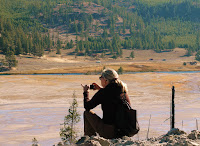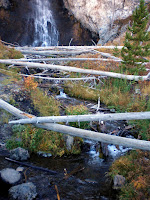One of the best ways to experience Yellowstone is to get out of the car and hike a trail. Yellowstone has over 900 miles of trails that vary in length and ability levels including about 15 miles of boardwalk trails.
During one of our Yellowstone visits, we hiked the trail to
Fairy Falls (2.5 miles one way). Beyond the falls, the trail
continues to Imperial Geyser (another 7/10’s of a mile one way) for a total distance of 6.4 miles (round trip).
There are three locations to access a trail to Fairy Falls:
1. One mile south of the Firehole River bridge on the Fountain Flat
Drive (hike is 3 miles, one way);
2. South on the Fountain Flat Drive to the barricade signaling the
end of road for vehicular traffic (hike is 2.5 miles, one way); and
3. Trailhead parking lot – one mile south of the Midway Geyser
Basin parking area (hike is 2.5 miles, one way).
This September morning, the air is cool but the afternoon temperature
is expected to be unseasonably warm. Knowing this, we want to be off
the trail by noon (it didn’t happen). We drive to the trailhead
near the Midway Geyser Basin because it is closest to where we are staying (Old Faithful).
NPS Map
At the beginning of the trail is an unnamed thermal feature near the Firehole River.
Unnamed Thermal Feature
For the first mile, the trail follows a wide dirt road. We were told to watch for a steep spur trail (about 9/10’s of a
mile from the trailhead) that would lead to an overlook at the edge
of the hillside with an outstanding view of Grand Prismatic Spring. *In 2010, this was an unofficial trail.
We
hiked
up the hillside following the trail left by others who
came before us. We
find the viewpoint and sit
on a rock watching
the cool morning breezes moving the clouds of steam across the
Spring. *Since this was
such a popular thing to do,
the National Park Service has
established an official
trail to the overlook with an observation deck.
View of Trail
We hang around here for about 75 minutes. During that time, we get
momentary windows of opportunity to photograph the colorful spring
from this elevated vantage point.
Grand Prismatic Spring
By now, we realize that we will be on the trail longer than we expected. We need to keep moving. Fairy
Falls is another 1.7 miles down the trail and Imperial Geyser is
beyond the falls.
Back on the main trail, we see Grand Prismatic Spring but its shape
and size is not as obvious at ground level.
Grand Prismatic Spring
We continue hiking the trail to Fairy Falls passing through a new
growth pine forest. My hubby did some backpacking here in the early
1980’s. He wanted to show me his backcountry campsite but things
have changed over the years and he doesn’t recognize where it was.
We continue hiking until we reach Fairy
Falls. Here is where Fairy Creek drops 200 feet creating a
delicate waterfall cascading down the rock wall into a small pool.
The area is littered with fallen tree trunks – nature’s
furniture. We pick one to sit down on and listen to the relaxing
sounds of the waterfall. We spend the next hour photographing the
falls and enjoying the coolness of this rocky alcove. This is a
great spot to be on a warm afternoon.
Fairy Falls
Fairy Falls - Close Up
Fallen Logs over Fairy Creek
From here, the trail continues to Imperial Geyser. After crossing a
short wooden footbridge built over Fairy Creek, we leave the cool
shade behind us and hike the sunlit trail.
Footbridge over Fairy Creek
Along the trail to Imperial Geyser, we pass Spray Geyser. It's a small
but steady geyser just
off the trail a bit. While we are here, a passing hiker
informs us that we are only two or three minutes from Imperial Geyser.
Spray Geyser along the trail to Imperial Geyser
A few minutes later, we see
Imperial Geyser. It
erupts 6-80 feet (we see mostly 6-15 feet bursts) spewing water into
the 75’ x 100’ alkaline pool of clear blue water. Orange and
yellow-colored run-off edges the pool and creates a narrow thermal
creek.
Imperial Geyser
Imperial Geyser
Thermal Run-Off
The return hike to the trailhead is warmer under the afternoon sun.. Once back at the car, we return to Old Faithful for a
late lunch/early dinner at the Snack Bar (burger/fries combo)
followed by a double scoop of Bunny Tracks Ice Cream at the Old
Faithful Inn. I can’t please everybody … Seymour Moose didn’t
want Bunny Tracks – he wanted Moose Trax. Since he wouldn’t eat
it – I did and it was yummy!
Seymour Moose with Bunny Tracks Ice Cream
No matter how many times I visit Yellowstone, I never get tired of
seeing its ever-changing scenery. I invite you to view my other blog
posts on Yellowstone National Park by clicking on the following
links:
Yellowstone: Mud Volcano - Stop and Smell the ... Sulfur?
Hiking Yellowstone: NW Corner - More Space; Less Crowded
Hiking Yellowstone: NW Corner - More Space; Less Crowded
Planning a visit to Yellowstone? Food and lodging options are
available inside the park and in the towns just outside the park
(West Yellowstone, Gardiner, and Cooke City/Silver Gate – all in
Montana). I highly recommend making lodging reservations in advance.
Yellowstone is a popular destination and “No Vacancy” signs are
common especially during the peak summer months. Since opinions,
preferences, and budgets vary, I suggest checking a trusted travel
source for current reviews.
My best advice is this - don’t just drive through Yellowstone –
experience it!
The National Park Service has created a series of short videos titled
“Inside Yellowstone”. It’s a fast and fun way to learn about
the Park. Click on the following link to begin this Yellowstone
experience.
Family vacations created some of my favorite memories. To start
planning your memorable trip to Yellowstone, please click on the
following link:





















